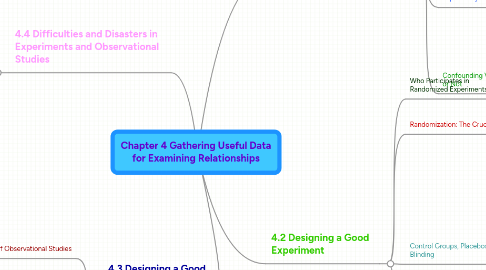
1. 4.3 Designing a Good Observational Study
1.1. Types of Observational Studies
1.1.1. Retrospective and Prospective Studies
1.1.1.1. A retrospective study uses data from the past
1.1.1.2. A prospective case study follows particiapnts into the future and uses data from the future time
1.1.2. Case-Control Studies
1.1.2.1. Compares individuals with a condition and individuals without the condition to determine whether cases and controls differ with respect to explanatory variables of interest
1.2. Advantages of Case-Control Studies
1.2.1. Efficiency
1.2.2. Reduces Potential Confounding Variables
2. 4.4 Difficulties and Disasters in Experiments and Observational Studies
2.1. Confounding Variables and The Implication of Causation in Observational Studies
2.2. Hawthorne and Experimenter Effects
2.2.1. The Hawthorne effect is when participants respond differently than normal, simple because they are in an exaperiment
2.2.2. Experimenter effects include recording data to match desired outcome, treating units differently depending on the treatment being given, and making participants aware of the desired outcome
2.3. Ecological Validity and Generalizability
2.4. RULE for Concluding Cause and Effect: cause-and-effect relationships can be inferred from randomized experiments but not observational studies
2.5. Extending results inappropriatley
2.6. Interacting variables
2.7. Using the past as a source for data
3. 4.1 Speaking the Language of Research Studies
3.1. Types of Research Studies
3.1.1. Observational Studies
3.1.1.1. Researchers simply observe or question the participants about opinons, behaviors, or outcomes
3.1.2. Experiments
3.1.2.1. Experiment
3.1.2.1.1. Researchers manipulate something and measure the effect of the manipulation on some outcome of interest
3.1.2.2. Randomized Experiment
3.1.2.2.1. Participants are randomly assigned to participate in one condition or another
3.2. Who is measured : Units,Subjects, Participants
3.2.1. Researchers use a variety of terms to describe who is measured such as unit,experimental unit,subjects, and participants
3.3. Explanatory and Response Variables
3.3.1. An explanatory, somtimes called an independent variable, is one that may explain or may cause differences in a response variable
3.3.2. A response variable, sometimes called an outcome or dependent variable
3.4. Confounding Variables -Measured or Not
3.4.1. A confounding variable affects the response variable and is related to the explanatory variable
3.4.2. Lurking variable: a possible confounding variable not measured or considered in the interpretation of the study
4. 4.2 Designing a Good Experiment
4.1. Who Participates in Randomized Experiments?
4.1.1. Volunteers
4.2. Randomization: The Crucial Element
4.2.1. In experimentation we want to make sure that the experimenters do not have the flexibility to choose which of the units receive each of the potential treatments
4.3. Control Groups, Placebos, and Blinding
4.3.1. Control Groups: treated identical except do not receive treatment
4.3.2. Placebos: looks like the real treatment but has not active ingredients
4.3.3. Blinding
4.3.3.1. Double Blind experiment is one in which neither the participant nor the researcher taking the measurements knows who had the treatment
4.3.3.2. Single Blind experiment is one in which the participants do not know which treatmentthey have been assigned
4.3.3.3. Double Dummy is used in an experiemnt to compare two treatments, so each group receives on treatment and one placebo
4.4. Design Terminology and Examples
4.4.1. Completely Randomized
4.4.2. Matched-Pair
4.4.3. Randomized Block
4.4.3.1. Repeated-Measure
